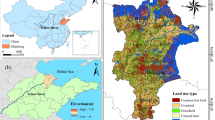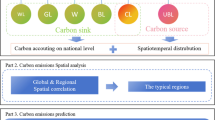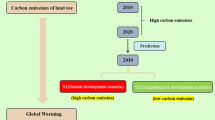Abstract
China’s rapid economic development has initiated the deterioration of its ecological environment, posing a threat to the sustainable development of human society. As a result, an assessment of regional sustainability is critical. This paper researches China’s most forested province, Fujian Province, as the study area. We proposed a grid-based approach to assess the regional carbon footprint in accordance with the Intergovernmental Panel on Climate Change’s (IPCC) carbon emission guidelines. Our method of assessment also introduced carbon emission indicators with our improved and published Net Primary Production (NPP) based on process simulation. The carbon footprint in Fujian Province from 2005–2017 was calculated and examined from a spatiotemporal perspective. Ecological indicators were used in the sustainability assessment. The research draws the following conclusions: 1) the carbon footprint in the eastern regions of Fujian Province was higher due to rapid economic development; 2) that of the western regions was lower; 3) an uptrend in the carbon footprint of Fujian Province was observed. All five ecological indicators based on carbon emissions and economic and social data showed an ecologically unsustainable trend over 13 years in the research area due to unsustainable economic development. Therefore, it is urgent to balance the relationship between economic development and environmental protection. Our research provides scientific references for achieving ecological civilization and sustainability in a similar region.
Similar content being viewed by others
References
Bahl O P, Dhami T L (2007). Surface energetics, interface and mechanical properties of carbon/carbon composites. J Catal, 248(2): 226–234
Benjaafar S, Li Y, Daskin M (2013). Carbon footprint and the management of supply chains: insights from simple models. IEEE Trans Autom Sci Eng, 10(1): 99–116
Berners-Lee M, Howard D C, Moss J, Kaivanto K, Scott W A (2011). Greenhouse gas footprinting for small businesses—the use of input-output data. Sci Total Environ, 409(5): 883–891
Brown M A, Southworth F, Sarzynski A (2009). The geography of metropolitan carbon footprints. Policy Soc, 27(4): 285–304
Browne D, O’Regan B, Moles R (2009). Use of carbon footprinting to explore alternative household waste policy scenarios in an Irish cityregion. Resour Conserv Recycling, 54(2): 113–122
Burnham A, Wang M Q, Wu Y (2006). Development and applications of GREET 2.7-The Transportation Vehicle-CycleModel. Energy
Canadell J G, Le Quéré C, Raupach M R, Field C B, Buitenhuis E T, Ciais P, Conway T J, Gillett N P, Houghton R A, Marland G (2007). Contributions to accelerating atmospheric CO2 growth from economic activity, carbon intensity, and efficiency of natural sinks. Proc Natl Acad Sci USA, 104(47): 18866–18870
Cao B, Lin J, Cui S (2010). Scenario analysis of reduction potentials of energy demand and GHG emissions based on LEAP model in Xiamen City. Acta Ecol Sin, 30(12): 3358–3367.
Chacko S, Ravichandran C, Vairavel S M, Mathew J (2019). Employing measurers of spatial distribution of carbon storage in Periyar Tiger Reserve, Southern Western Ghats, India. Journal of Geovisualization and Spatial Analysis, 3(1): 1
Chen Z, Wang Z, Sun Y (2015). Spatial changing pattern of carbon dioxide emissions per capita and club convergence in China. J Arid Land Resour Enviro, 29(4): 24–29
Cole A (2009). More treatment in surgeries and at home will help cut NHS carbon footprint. BMJ, (338): b345
Crabtree R, Potter C, Mullen R, Sheldon J, Huang S, Harmsen J, Rodman A, Jean C (2009). A modeling and spatio-temporal analysis framework for monitoring environmental change using NPP as an ecosystem indicator. Remote Sens Environ, 113(7): 1486–1496
Danish H, Hassan S T, Baloch M A, Mahmood N, Zhang J W (2019). Linking economic growth and ecological footprint through human capital and biocapacity. Sustain Cities Soc, 47: 10
Ding J, Yang J (2017). Study on the ecological pressure of carbon footprint of energe in Fujian Province. Science Technology and Industry, 17(4): 16–20
Druckman A, Jackson T (2009). The carbon footprint of UK households 1990–2004: a socio-economically disaggregated, quasi-multi-regional input-output model. Ecol Econ, 68(7): 2066–2077
Fabricant S (1952). The Structure of American Economy, 1919–1939: An Empirical Application of Equilibrium Analysis. 2nd ed. New York: 4Oxford University Press
Fang K (2014). Multidimensional assessment of national environmental sustainability based on footprint family and planetary boundaries. Ecology and Environmental Sciences, 23(11): 1868–1875
Field C B, Randerson J T, Malmström C M (1995). Global net primary production: combining ecology and remote sensing. Remote Sens Environ, 51(1): 74–88
Finkbeiner M (2009). Carbon footprinting—opportunities and threats. Int J Life Cycle Assess, 14(2): 91–94
Geng Y, Dong H, Xi F, Liu Z (2010). A review of the research on carbon footprint responding to climate change. China Population · Resources and Environment, 20(10): 6–12
Giurco D, Petrie J G (2007). Strategies for reducing the carbon footprint of copper: new technologies, more recycling or demand management? Miner Eng, 20(9): 842–853
Gocic M, Trajkovic S (2013). Analysis of changes in meteorological variables using Mann-Kendall and Sen’s slope estimator statistical tests in Serbia. Global Planet Change, 100: 172–182
Gu C L, Tan Z B, Liu W, Yu T F, Han Q, Liu H, Dai Y X, Liu Z L, Zheng S Q (2009). A study on climate change, carbon emissions and lowcarbon city planning. Urban Planning Forum, 22(3): 38–45
Hammond G (2007). Time to give due weight to the ‘carbon footprint’ issue. Nature, 445(7125): 256
Hertwich E G, Peters G P (2009). Carbon footprint of nations: a global, trade-linked analysis. Environ Sci Technol, 43(16): 6414–6420
Hillman T, Ramaswami A (2010). Greenhouse gas emission footprints and energy use benchmarks for eight US cities. Environ Sci Technol, 44(6): 1902–1910
Hu S, Xiang R, Dong J, Qi Z (2016). The sustainable development of vegetable production system from the carbon footprint perspective in Hubei Province. Research of Agricultural Modernization, 37(3): 460–467
Huang Y A, Lenzen M, Weber C L, Murray J, Matthews H S (2009). The role of input-output analysis for the screening of corporate carbon footprints. Econ Syst Res, 21(3): 217–242
Hulme M (2017). Intergovernmental Panel on Climate Change (IPCC). New York: John Wiley & Sons
Iribarren D, Hospido A, Moreira M T, Feijoo G (2010). Carbon footprint of canned mussels from a business-to-consumer approach: a starting point for mussel processors and policy makers. Environ Sci Policy, 13(6): 509–521
Johnson E (2008). Disagreement over carbon footprints: a comparison of electric and LPG forklifts. Energy Policy, 36(4): 1569–1573
Johnson E (2009). Charcoal versus LPG grilling: a carbon-footprint comparison. Environ Impact Assess Rev, 29(6): 370–378
Kendall M G (1990). Rank correlation methods. Br J Psychol, 25(1): 86–91
Kennedy C, Steinberger J, Gasson B, Hansen Y, Hillman T, Havránek M, Pataki D, Phdungsilp A, Ramaswami A, Mendez G V (2010). Methodology for inventorying greenhouse gas emissions from global cities. Energy Policy, 38(9): 4828–4837
Kenny T, Gray N F (2009). Comparative performance of six carbon footprint models for use in Ireland. Environ Impact Assess Rev, 29 (1): 1–6
Kim B, Neff R (2009). Measurement and communication of greenhouse gas emissions from US food consumption via carbon calculators. Ecol Econ, 69(1): 186–196
Lal R (2004). Carbon emission from farm operations. Environ Int, 30(7): 981–990
Li J, Cui Y, Liu J, Shi W, Qin Y (2013). Estimation and analysis of net primary productivity by integrating MODIS remote sensing data with a light use efficiency model. Ecol Modell, 252(1): 3–10
Mann H B (1945). Nonparametric tests against trend. Econometrica, 13 (3): 245–259
Nourani V, Mehr A D, Azad N (2018). Trend analysis of hydroclimatological variables in Urmia lake basin using hybrid wavelet Mann-Kendall and Sen tests. Environ Earth Sci, 77(5): 207
Pathak H, Jain N, Bhatia A, Patel J, Aggarwal P K (2010). Carbon footprints of Indian food items. Agric Ecosyst Environ, 139(1–2): 66–73
Qi C Y, Dong Y S (2004). Emission of greenhouse gases from energy field and mitigation countermeasures in China. Scientia Geographica Sinica, 24(5): 528–534
Qiang L, Xing Z, Jiang K J, Han W K (2008). Energy and carbon embodied in main exporting goods of China. China Industrial Economics, 22(8): 46–55
Qin D, Stocker T (2014). Highlights of the IPCC working group I fifth assessment report. Advances in Climate Change Research, 10(1): 1–6
Quadrelli R, Peterson S (2007). The energy-climate challenge: recent trends in CO emissions from fuel combustion. Energy Policy, 35(11): 5938–5952
Ramaswami A, Hillman T, Janson B, Reiner M, Thomas G (2008). A demand-centered, hybrid life-cycle methodology for city-scale greenhouse gas inventories. Environ Sci Technol, 42(17): 6455–6461
Rees W E (1992). Ecological footprints and appropriated carrying capacity: what urban economics leaves out. Focus, 6(2): 121–130
Rong P, Yang Q, Qin Y, Li X, Zhang T, Zhang S (2016). Energy-related carbon emission security at the provincial level in China. Progress in Geography, 35(4): 487–495
Running S W, Nemani R R, Heinsch F A, Zhao M S, Reeves M, Hashimoto H (2004). A continuous satellite-derived measure of global terrestrial primary production. Bioscience, 54(6): 547–560
Shi M, Wang Y, Zhang Z (2012). Regional carbon footprint and interregional transfer of carbon emissions in China. Acta Geogr Sin, 67(10): 1327–1338
Solomon S, Plattner G K, Knutti R, Friedlingstein P (2009). Irreversible climate change due to carbon dioxide emissions. Proc Natl Acad Sci USA, 106(6): 1704–1709
Tosunoglu F, Kisi O (2017). Trend analysis of maximum hydrologic drought variables using Mann-Kendall and Sen’s innovative trend method. River Res Appl, 33(4): 597–610
Wackernagel M, Onisto L, Bello P, Callejas Linares A, Susana López Falfán I, Méndez García J, Isabel Suárez Guerrero A, Guadalupe Suárez Guerrero M (1999). National natural capital accounting with the ecological footprint concept. Ecol Econ, 29(3): 375–390
Wackernagel M, Rees W (1997). Our ecological footprint. Green Teach (Tor), 45: 5–14
Wang C J, Zhang X L, Wang F, Lei J, Zhang L (2015a). Decomposition of energy-related carbon emissions in Xinjiang and relative mitigation policy recommendations. Front Earth Sci, 9(1): 65–76
Wang Q F, Shi P J, Lei T J, Geng G P, Liu J H, Mo X Y, Li X H, Zhou H K, Wu J J (2015b). The alleviating trend of drought in the Huang-Huai-Hai Plain of China based on the daily SPEI. Int J Climatol, 35 (13): 3760–3769
Wang Q F, Tang J, Zeng J Y, Leng S, Shui W (2019). Regional detectiong of multiple change points and workable application for precipitation by maximum likelihood approach. Arab J Geosci, 12 (23): 745
Wang Q F, Wu J J, Lei T J, He B, Wu Z T, Liu M, Mo X Y, Geng G P, LiX H, Zhou H K, Liu D C (2014). Temporal-spatial characteristics of severe drought events and their impact on agriculture on a global scale. Quat Int, 349: 10–21
Wang Q F, Wu J J, Li X H, Zhou H K, Yang J H, Geng G P, An X L, Liu L Z, Tang Z H (2017). A comprehensively quantitative method of evaluating the impact of drought on crop yield using daily multi-scale SPEI and crop growth process model. Int J Biometeorol, 61(4): 685–699
Wang Q F, Tang J, Zeng J Y, Qu Y P, Zhang Q, Shui W, Wang W L, Yi L, Leng S (2018a). Spatial-temporal evolution of vegetation evapotranspiration in Hebei Province, China. J Integr Agric, 17(9): 2107–2117
Wang Q F, Zeng J Y, Leng S, Fan B X, Tang J, Jiang C, Huang Y, Zhang Q, Qu Y P, Wang W L, Shui W (2018b). The effects of air temperature and precipitation on the net primary productivity in China during the early 21st century. Front Earth Sci, 12(4): 818–833
Wang W, Lin J, Cui S, Lin T (2010). An overview of carbon footprint analysis. Environ Sci Technol, 33(7): 71–78
Weber C L, Matthews H S (2008). Quantifying the global and distributional aspects of American household carbon footprint. Ecol Econ, 66(2–3): 379–391
Welch B, Iffert M, Skyllas-Kazacos M (2008). Applying fundamental data to reduce the carbon dioxide footprint of aluminum smelters. JOM, 60(11): 17–24
Xie B, Qin Z, Wang Y, Chang Q (2014). Spatial and temporal variation in terrestrial net primary productivity on Chinese Loess Plateau and its influential factors. Agr Eng and sustainability, 30(11): 244–253
Xie S C, Chen C H, Li L, Huang C, Cheng Z, Dai P, Lu J (2009). The energy related carbon dioxide emission inventory and carbon flow chart in Shanghai City. China Environmental Science, 29(11): 1215–1220.
Xiu X, Chen Q (2015). Analysis on correlation between economic development and carbon footprint in Fujian Province. Journal of Fujian Agriculture and Forestry University (Philosophy and Social Sciences), 18(6): 40–46
Xu G Q, Liu Z Y, Jiang Z H (2006). Decomposition model and empirical study of carbon emissions for China, 1995–2004. China Population Resources and Environment, 16(6): 158–161
Zhang R, Jianchao X I, Quansheng G E (2015). Life cycle of tourist carbon footprint (TCF-LCA): a “low carbon tourism” measurement method. Journal of Arid Land Resources and Environment, 29(6): 169–175
Acknowledgements
This research received financial support from the National Natural Science Foundation of China (Grant No. 41601562), also sponsored by China Scholarship Council (No. 201806655014), the Research Project for Young Teachers of Fujian Province (No. JAT160085), and the Scientific Research Foundation of Fuzhou University (No. XRC-1536).
Author information
Authors and Affiliations
Corresponding author
Rights and permissions
About this article
Cite this article
Zeng, J., Zhang, R., Tang, J. et al. Ecological sustainability assessment of the carbon footprint in Fujian Province, southeast China. Front. Earth Sci. 15, 12–22 (2021). https://doi.org/10.1007/s11707-020-0815-3
Received:
Accepted:
Published:
Issue Date:
DOI: https://doi.org/10.1007/s11707-020-0815-3




